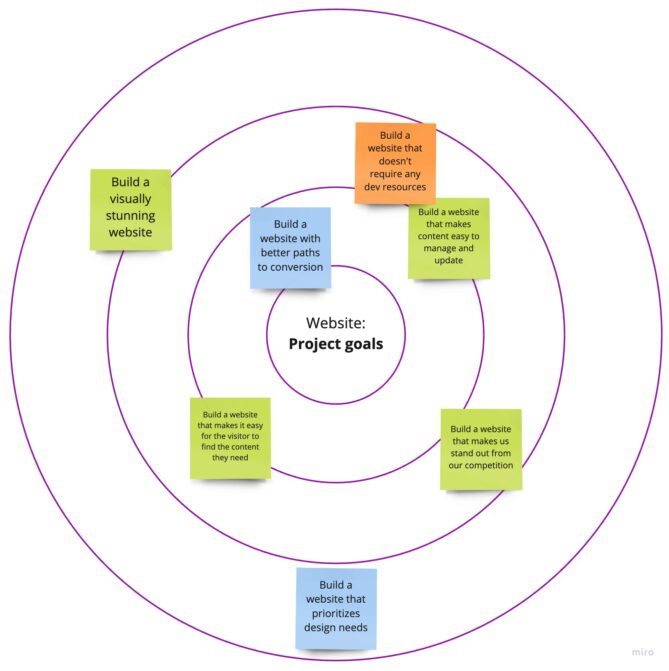What makes a project successful?
This is the question every great Project Manager asks themselves when kicking off a new project. Delivering successful projects comes down to one (not so) simple thing: Defining what project success looks like to stakeholders.
The success of your project depends on your ability as a Project Manager to define goals, use resources strategically, remove roadblocks, and move projects forward.
That’s a fair few things to take into consideration when planning a new project. So where do you start? Well, that’s the easy part.
Ask your client what project success means to them.
In this article 📖
Ask what project success means to your client
Before the project kicks off, it’s important to understand what project success means to your client. Take the opportunity to ask questions early and manage expectations accordingly. There will be gaps in knowledge about the client, the product, product development, resources, and other things—and that’s OK.
The only way to get to the bottom of client expectations is to ask questions and clarify assumptions. Feel like you’re asking stupid questions? Don’t. Most clients will appreciate that you’re thorough. It demonstrates that they’re working with an engaged team that’s invested in delivering a project that’s successful. Those “stupid” questions might very soon result in a very happy client.
Define project success criteria
Bring your project team and client together to discuss and define your project success criteria. The criteria might look different depending on how many stakeholders you have on the client side. That’s why it’s important to involve everyone from the beginning.
Give everyone 10 minutes to brainstorm what success looks like for:
- The meeting – e.g establish project success criteria that everyone’s happy with.
- The project – e.g deliver the project on time and on budget.
- The business – e.g the project drives 2x more revenue for the business by the end of the year.
Next, ask the team to brainstorm what the opposite of success is. Have them complete the sentence: “This project will be unsuccessful if…”
For example, let’s say you’ve been tasked to design and develop a new website for a client. Then the above sentence might read “This project will be unsuccessful if the new website is worse than the old one.”
Now, “worse” is a pretty generic and potentially subjective statement. What does “worse” mean? That’s why it’s essential to drill deeper into people’s answers.
Assess the group’s answers by:
- Having everyone share the reasoning behind their statements
- Grouping similar factors and label those groupings
- Removing duplicates in each category
- Discussing how you would tackle the issues that might jeopardize project success
Once you understand the factors that might affect the project performance and its criteria for success, the next step is to set goals for the project.

“Resource Guru has significantly improved our visibility, boosting project ownership and forecasting ability.”
Define the project scope and set measurable goals
The planning phase is crucial. This is the time to solidify the full scope of the project including goals, tasks, resources, timeline, and budget. Your team should work with your client to define all these areas. If not, you risk delays, budget issues, or, worst case scenario – scope creep.
Setting and prioritizing project goals
Let’s be real. Setting goals is hard. And with new projects, it can be especially difficult to fully grasp what’s realistic and not before you’re in it. But goals are important – they’re what you’ll be measuring project success against. When you’re able to measure those specific goals throughout your project, you can make adjustments faster and keep your project on track.
It may seem obvious to set specific and measurable goals, but it’s a common mistake not to. Using goals that are directly tied to the success criteria, the more likely you are to hit the benchmark for project success.
But when just about everything seems important, how do you go about prioritizing project goals?
It’s time to use the project success criteria you established with your client earlier. Bring your whole team and the client together to brainstorm, identify, and prioritize the goals of the project.
- Create a mind map of your goals with your team. Use an online tool like Miro or Mural if you’re working remotely or asynchronously or post-its if you’re meeting in person.
- Ask everyone to take five minutes and brainstorm what they think the goals of the project are.
- Have each person read their ideas out loud and suggest where they should go on the mind map. The more important the goal or objective, the closer to the center of the mind map it should go.
- Limit the number of goals that can be in the rings closest to the center. That way, you’ll force the team to prioritize.
- Create a simplified version of the mind map by transferring only the inner rings (the most important goals) into a simplified version or a list of priorities.
- Make the goals visible and accessible to everyone so they can refer back to them while working on the project.
Using the website example, here’s a simplified version of what you might end up with:

By asking the client to prioritize their most important goals, it’ll give you the clarity you need to remove roadblocks and move the project forward. Once you’ve set and prioritized your goals, you’ll be able to create a project plan that’s directly tied to the goals you’ve agreed on.
Create a detailed project plan
You’ve identified your goals, now it’s time to get to work and create a project plan that will meet those goals and ensure project success.
Easier said than done, right? Our favorite tactic? Work backward from the goals you’ve set.
Connect each goal to key tasks that will help achieve those goals. Next, add as many sub-tasks as necessary to those key tasks. This will help you paint a full picture of what’s needed for project success.
Let’s use the website example again to see what that could look like.
Goal: Deliver a website that makes it easy for the client to add and update the content themselves.
Key task: Choose a CMS that’s flexible and easy to use for non-technical users and requires no development resources.
Sub-tasks:
- Evaluate CMSs that fit the client’s criteria
- Implementation speed
- Features
- Scalability
- Security etc
- Review technical documentation of the CMS to ensure it fits the criteria
- Assess pricing and make sure the total doesn’t go over budget even if the team grows
Resources:
- Marketing to evaluate overall fit
- Designer to assess any design limitations
- Engineering to review technical documentation
The more detailed your project plan is the less room for assumptions and surprises for both your project team and the client. Use a project scheduling tool to make sure no one will sit around and wonder what they should do on any given day.
Project success is a team sport
Just as important as it is to identify the goals and outline the key tasks, it’s just as important to have the right people performing those tasks. Because what does it matter if you’ve got everything else down to a tee if you don’t have the right people for the job?
That’s right. A lot of projects fail because of poor resource management. Perhaps the people with the right skills were assigned to a different project, the space was double-booked, or the equipment you needed wasn’t available. Trust us, resource management is everything.
So once your project plan has been drafted, it’s time to look over your resource management strategy.
Choose a resource management strategy that will ensure project success
Any project, no matter the size, will always have challenges. Whether it’s the timeline, budget, or resources, a resource management plan will increase your chances of meeting your goals and ensure project success.
Here are four resource management techniques we recommend.
1. Use resource leveling to adjust task deadlines
Resource leveling is a project management technique that prioritizes your people, materials, and time by choosing start and end dates for projects based on when resources will be available.
For example, if, during the planning phase, you know a key team member will be on paternity leave at the halfway point of the project, you might push the deadline back several months to save that team member the experience of returning to full capacity during a stressful time in their life just to meet a deadline. Resource leveling helps you treat your team like people and not like robots who can jump back into work at full speed. But sometimes, resource leveling isn’t enough.
2. Use resource smoothing to identify critical tasks
Resource smoothing is a tool for project management success that helps you meet your deadlines by getting rid of unnecessary tasks without highs and lows in the availability of resources.
As an example, you might choose to use resource smoothing when a client is pushing for an earlier deadline. Using your scheduling or resource management tool, you can pinpoint which team members are over or under-utilized. You can easily decide to reallocate resources or if you need to hire a freelancer. Once you’ve used resource smoothing to adjust your tasks and move your resources around, you and your project team can feel confident in your decision to bump the deadline up.
3. Stay on top of resource utilization to avoid allocation issues
Resource utilization refers to the number of hours your team members and material resources are allocated during a given timeline. It addresses two key performance indicators: overutilization and underutilization. Monitoring resource utilization helps you avoid employee burnout mid-project (overutilization) or missed opportunities to get ahead on the project (underutilization). A good rule of thumb is to keep resource utilization around 70-80% for each employee.
4. Use resource forecasting to anticipate needs
Resource forecasting anticipates your team’s future resource needs. You can forecast project bottlenecks, such as projects that will need more developers than average. It helps you be better prepared and better manage expectations for the project.
For more on these methodologies, check out our 6 resource management techniques for successful projects and happier employees.
Communication is key to project success
Any seasoned PM knows that overcommunicating is the name of the game. To help things run smoothly from the get-go, these are a few things you can cover.
Create a project glossary
Shared language improves the chances of project success. So if you’re working with a client or in an industry that uses terminology you’re not familiar with, start a collaborative project glossary. As you come across unknown terms, ask your client to define them, then keep the definitions in a place your project team can easily find. This can also be a great way to quickly get someone new to the team up to speed. It’s very simple – but incredibly practical.
Make use of existing materials
Unless a project is a brand new initiative, there will typically be a bunch of information or existing material you can use to get a better understanding of what you’re dealing with.
Let’s go back to the website example one more time. By auditing the existing website, CMS, and interviewing people using it, you’ll get a better look into their needs and pain points. Ultimately, the team will have a shared understanding of what you’re building and what “good” looks like to the client. And what will that lead to? You guessed it. Higher chance of project success.
Hold regular progress meetings
Regular check-ins are a must for any project. Create a checklist for your progress meetings that include the goals of the project and how well you’re tracking against both goals and deadlines. But let’s not forget about the team itself. Discuss how collaboration is going, transparency, feedback, communication with the client, and any other factors that could impact performance.
Regular progress meetings will help you see how your process is doing overall and identify any roadblocks that could stand in the way of project success.
Revisit your project success goals often
During the project, you might feel that you’re losing sight of some of the goals you’ve set. Whenever this is happening, get the team and the client together to review the project success criteria and the goals you established in the beginning and discuss whether or not you’re on track.
Goals can change over time, if that’s the case, make sure new goals are added to the project plan and that key tasks are updated accordingly if needed. The same goes for the resources involved.
Evaluate your project based on success criteria
Just because a project is over, doesn’t always mean it’s complete. Once the time has come to get together with your team to evaluate how well you met your goals, refer back to your criteria for project success.
Let’s go back to our website example and let’s say one of the criteria was to outrank the competition on Google. That’s not something that’s going to be immediately measurable. In fact, most projects will have a set of criteria that has goals that will take some time to measure, and that’s okay.
Start with the goal and criteria that can be measured today, for a newly launched website, which could be:
- The value proposition is instantly clear
- The sign-up process is 5x faster than before
- It’s easy to find the content that you’re looking for
For the goals that can’t be measured at the time, create a reminder to revisit and evaluate when it’s possible to do so.
Create a complete project evaluation report to demonstrate how well you delivered on project success criteria and goals met. It’s also important to include valuable lessons learned and important takeaways. A few criteria you might include in the report are scope, cost, resources, quality, risk, and time.
Now that you’ve evaluated the project’s success, it’s time for the final piece of the puzzle: the project handover.
Set your client up for success at project handoff
You know you’ve done a successful project handover if your client never comes back to you with any questions.
Project handover documents have essential information someone would need to continue to run with a project. It’s one ginormous master checklist if you will.
Include the project success criteria and goals you defined at the very beginning of the project, and explain the outcomes. Include all the relevant correspondence, the project evaluation, and anything your client needs if they have questions about the project post-handoff. For best practice, have a Customer Success Manager follow up on the long-term project success and gather feedback.
Project success doesn’t just happen
Remember, successful projects aren’t happy accidents—they’re planned. By defining success criteria, setting realistic goals, and setting a flexible resource management strategy, you’ll have all the power in the world to deliver a successful project.
And remember, the next time you’re getting started on a project, don’t be afraid to ask the “stupid” questions. Because the answers to project success might be hiding right in front of you.
Related Resource Guru reads:






